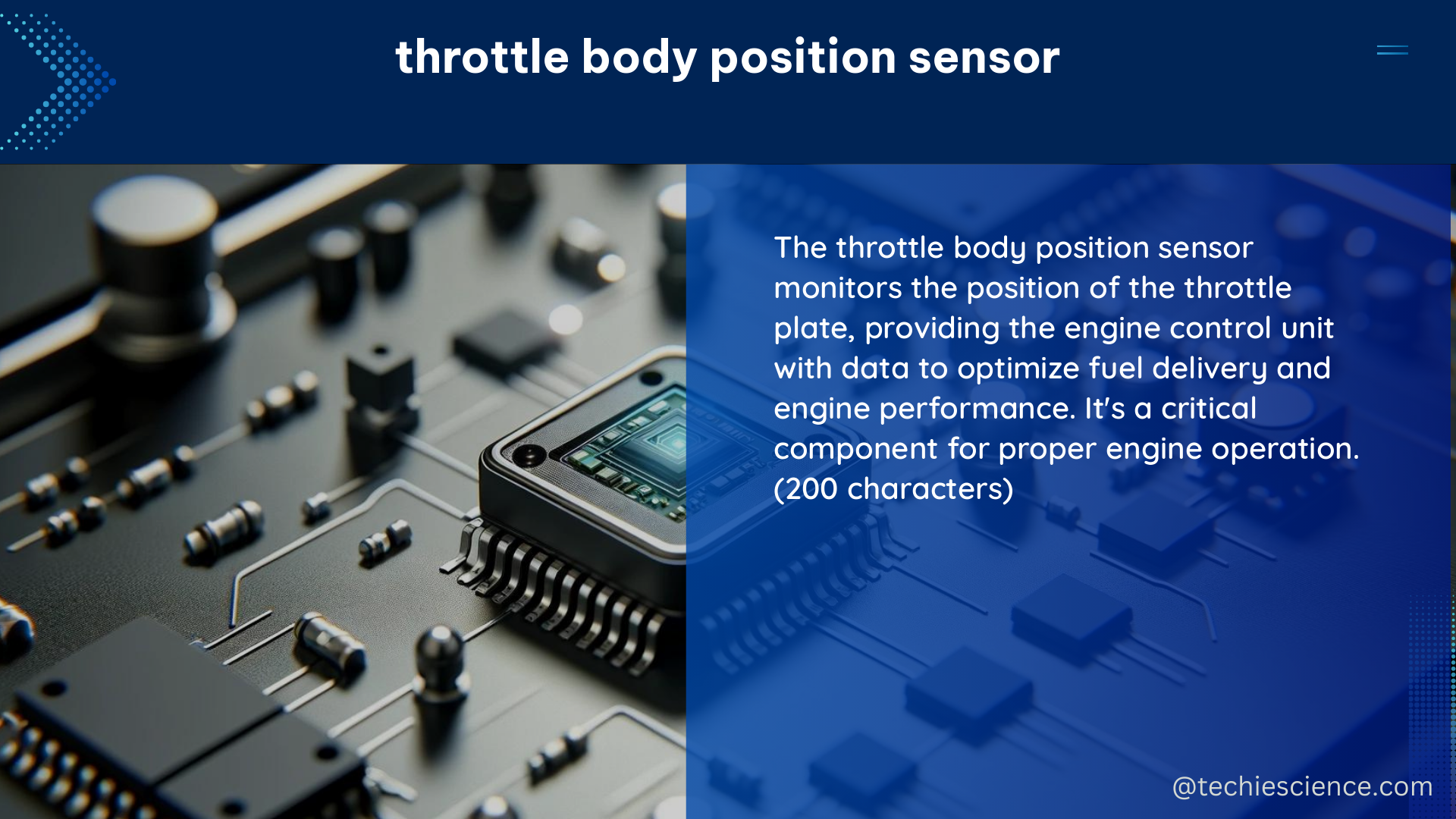The throttle position sensor (TPS) is a critical component in modern vehicle engine management systems, responsible for measuring the position of the throttle valve and transmitting this data to the engine control unit (ECU). This information is essential for the ECU to precisely adjust fuel injection and maintain optimal engine performance. Understanding the intricacies of the TPS is crucial for maintaining a well-functioning vehicle.
Types of Throttle Position Sensors
There are two primary types of throttle position sensors used in modern vehicles:
- Potentiometer-based TPS:
- This type of TPS consists of a variable resistor connected to the throttle shaft.
- As the throttle is opened, the resistance across the potentiometer changes, providing a voltage signal to the ECU.
- The ECU uses this signal to determine the throttle position and adjust fuel injection accordingly.
-
Typical resistance range: 2.5 to 6.8 kΩ
-
Hall Effect-based TPS:
- This type of TPS uses a magnetic field to detect the throttle position.
- A small magnet is mounted on the throttle shaft, and as it rotates, it passes over a Hall effect sensor, generating a voltage signal.
- The ECU then uses this signal to determine the throttle position and adjust fuel injection accordingly.
- Typical voltage range: 0.5 to 4.5 V
Working Principle of Throttle Position Sensors

The working principle of a TPS involves measuring the angle of the throttle plate or lever and transmitting this data to the ECU. The TPS is typically a three-wire sensor, with two pins serving as the power terminal and ground, and the third pin connected to a sliding contact linked to the throttle shaft.
As the throttle rotates, the sliding contact moves along the resistor, causing a change in the sliding contact potential, which is converted into a throttle position signal. This signal is then sent to the ECU, which uses it to adjust the fuel injection and other engine parameters for optimal performance.
Throttle Position Sensor Specifications
The specifications for a throttle position sensor can vary depending on the vehicle model and manufacturer. However, some common specifications include:
- Voltage Range:
- Idle position: Typically less than 0.5 V
-
Wide-open throttle (WOT): Typically around 4 V
-
Resistance Range:
- Potentiometer-based TPS: 2.5 to 6.8 kΩ
-
Hall Effect-based TPS: 5.0 to 5.3 kΩ (between the 5V reference and ground terminals)
-
Linearity:
-
The throttle position sensor signal should change linearly with the throttle position, without any significant peaks or troughs.
-
Response Time:
- The TPS should respond quickly to changes in throttle position, typically within a few milliseconds.
Testing a Throttle Position Sensor
To test a throttle position sensor, follow these steps:
- Turn off the ignition switch and disconnect the wire harness connector on the throttle assembly.
- Measure the resistance between the throttle position sensor 5V reference terminal and the low-pressure reference terminal. The resistance should be within the specified range (5.0 to 5.3 kΩ). If not, replace the throttle assembly.
- Measure the resistance between the throttle assembler signal terminal and the low-pressure reference terminal. The throttle sensor should detect a full range, with the electrical resistance transforming between 2.5 to 6.8 kΩ, without any peak or trough. If not, replace the throttle assembly.
- Use a 5V voltage source and ground the applicable end terminal of the throttle sensor to detect the voltage between the signal terminal and the low-pressure reference terminal. The throttle sensor signal voltage should change with the throttle opening.
Troubleshooting Throttle Position Sensor Issues
Signal deviations in a TPS can indicate various problems. Here are some common issues and their potential causes:
- No Signal:
- Back probes having no connection
- No power supply
-
Sensor defect
-
Noisy Signal:
- Damaged wiring of the signal or power supply
- Poor connection in connector terminals
-
Sensor defect
-
Offset in the Signal:
- Scope not set to DC coupling
- Poor or no ground on the power supply
- Resistance in wiring to the ECU
Importance of Proper Throttle Position Sensor Maintenance
Maintaining the throttle position sensor is crucial for ensuring optimal engine performance and fuel efficiency. Regular inspection, proper installation, and the use of high-quality replacement parts can help ensure the TPS operates accurately and reliably. Addressing any warning signs or issues with the TPS promptly can help prevent further damage to the engine and improve overall vehicle performance.
Conclusion
The throttle position sensor is a critical component in modern vehicle engine management systems, responsible for providing the ECU with accurate information about the throttle position. Understanding the working principle, types, specifications, and testing methods of the TPS is essential for maintaining a well-functioning vehicle. By following best practices for TPS maintenance and troubleshooting, vehicle owners and technicians can ensure optimal engine performance and fuel efficiency.
References:
- Utmel. (2021-04-10). Working Principle and Types of Throttle Position Sensor. Retrieved from https://www.utmel.com/blog/categories/sensors/working-principle-and-types-of-throttle-position-sensor
- TPS (Throttle Position Sensor) Diagnosis and Understanding Pt1. (2014-10-02). Retrieved from https://www.youtube.com/watch?v=FJobCD6y8fk
- Tiepie Automotive. (n.d.). Measuring a throttle valve position sensor, single potentiometer. Retrieved from https://www.tiepie-automotive.com/en/articles/throttle-valve-position-sensor-single
- Quarktwin Electronic Parts. (2023-04-07). Throttle Position Sensor Complete Guide. Retrieved from https://www.quarktwin.com/blogs/sensor/throttle-position-sensor-complete-guide/74

The lambdageeks.com Core SME Team is a group of experienced subject matter experts from diverse scientific and technical fields including Physics, Chemistry, Technology,Electronics & Electrical Engineering, Automotive, Mechanical Engineering. Our team collaborates to create high-quality, well-researched articles on a wide range of science and technology topics for the lambdageeks.com website.
All Our Senior SME are having more than 7 Years of experience in the respective fields . They are either Working Industry Professionals or assocaited With different Universities. Refer Our Authors Page to get to know About our Core SMEs.